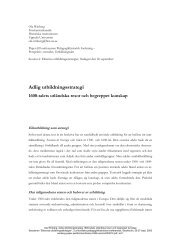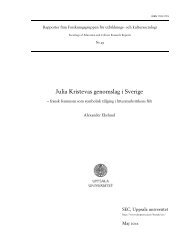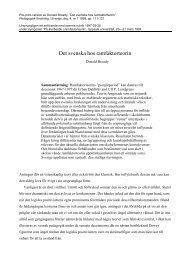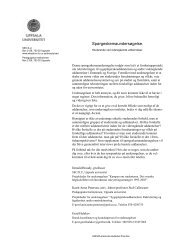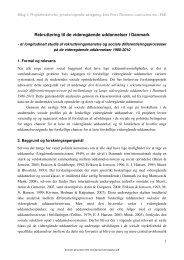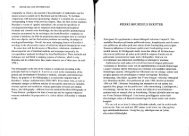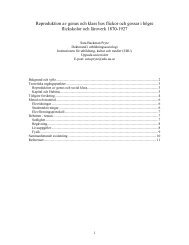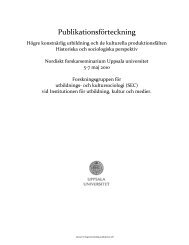exploring uses of digital archives in research and ... - skeptron.uu.se
exploring uses of digital archives in research and ... - skeptron.uu.se
exploring uses of digital archives in research and ... - skeptron.uu.se
You also want an ePaper? Increase the reach of your titles
YUMPU automatically turns print PDFs into web optimized ePapers that Google loves.
Another example is humanities <strong>in</strong> comput<strong>in</strong>g, work<strong>in</strong>g at the <strong>in</strong>ter<strong>se</strong>ction <strong>of</strong> comput<strong>in</strong>g,arts <strong>and</strong> humanities. In the humanities comput<strong>in</strong>g community, there is both a pragmaticfocus on application <strong>of</strong> comput<strong>in</strong>g <strong>in</strong> scholarship <strong>and</strong> teach<strong>in</strong>g, but also a theoretical focuson sociological <strong>and</strong> epistemological issues. One position po<strong>se</strong>d by Willard McCarty is thathumanities comput<strong>in</strong>g are an academic field <strong>of</strong> its own concerned with theoretical <strong>and</strong>epistemological issues like “how we know what we know”. On the other h<strong>and</strong> there is LouBurnard, who has a different st<strong>and</strong>po<strong>in</strong>t more related to the <strong>in</strong>herent logic <strong>and</strong> practices <strong>in</strong>different academic practices. He is pos<strong>in</strong>g the question: ‘What u<strong>se</strong> is this technology to myacademic concerns? A similar view is expres<strong>se</strong>d by Susan Hockey. 60One prom<strong>in</strong>ent example <strong>in</strong> the humanities doma<strong>in</strong> is the previously mentioned TEIcommunity. TEI was orig<strong>in</strong>ally developed as an application <strong>of</strong> SGML - an <strong>in</strong>terchangelanguage for textual data. This <strong>in</strong>terdiscipl<strong>in</strong>ary effort has been very successful <strong>and</strong> is nowwidely recogni<strong>se</strong>d as the st<strong>and</strong>ard format for scholarly text encod<strong>in</strong>g <strong>and</strong> textual<strong>in</strong>terchange. 61 The TEI community, have had an impact on the emerg<strong>in</strong>g mark-up<strong>in</strong>itiatives far beyond its own scholarly doma<strong>in</strong> by the contribution to the development <strong>of</strong>XML, the dom<strong>in</strong>ant st<strong>and</strong>ard for <strong>in</strong>formation <strong>in</strong>terchange format for web <strong>se</strong>rvices. 62Besides, text encod<strong>in</strong>g allows texts to be treated as <strong>re<strong>se</strong>arch</strong> tools <strong>in</strong> them<strong>se</strong>lves. That is,<strong>digital</strong> texts lend them<strong>se</strong>lves to much more than access, retrieval <strong>and</strong> read<strong>in</strong>g. Encodedtexts can help scholars do other k<strong>in</strong>ds <strong>of</strong> <strong>re<strong>se</strong>arch</strong> work. Full-text resources <strong>of</strong>fer, at leastthree, clear benefits; (i) a simple provision <strong>and</strong> access to <strong>of</strong> otherwi<strong>se</strong> scarce texts, (ii)advanced <strong>se</strong>arch opportunities either to identify particular motifs or words or to establishtheir ab<strong>se</strong>nce <strong>in</strong> certa<strong>in</strong> texts, <strong>and</strong> (iii) the ability to collate different editions <strong>of</strong> the samework for variants or to identify editorial changes. 63In a similar <strong>in</strong>terdiscipl<strong>in</strong>ary manner, yet with a totally different scope <strong>and</strong> aim, othercommunities are work<strong>in</strong>g on the development <strong>of</strong> external meta-data recommendations <strong>and</strong>st<strong>and</strong>ards for the <strong>in</strong>terchange <strong>of</strong> e.g. educational <strong>in</strong>formation between different platforms<strong>and</strong> contexts. In some <strong>of</strong> the<strong>se</strong> communities, such as the IMS project, they tend at a firstglance; to have a somewhat unproblematic view <strong>of</strong> what can be considered as elements <strong>of</strong>(pedagogical) data. Another example is the metadata recommendation Dubl<strong>in</strong> CoreMetadata Initiative, mentioned above, is an <strong>in</strong>itiative <strong>and</strong> a st<strong>and</strong>ard for catalogu<strong>in</strong>g<strong>in</strong>ternet resources <strong>and</strong> where there has been a tremendous will to work towards con<strong>se</strong>nsuson a simpler solution <strong>of</strong> <strong>in</strong>teroperability between different doma<strong>in</strong>s. Thus, by us<strong>in</strong>g a <strong>se</strong>t <strong>of</strong>m<strong>in</strong>imal requirements <strong>of</strong> how to describe resources the Dubl<strong>in</strong> Core are striv<strong>in</strong>g for mak<strong>in</strong>g<strong>in</strong>formation applicable, understood <strong>and</strong> u<strong>se</strong>ful <strong>in</strong> many different contexts.Communities <strong>of</strong> scientists <strong>and</strong> <strong>re<strong>se</strong>arch</strong>ers concerned <strong>and</strong> <strong>in</strong>terested <strong>in</strong> issues on electronictext, metadata <strong>and</strong> <strong>in</strong>teroperability are thus created around the globe with access toes<strong>se</strong>ntially the same <strong>in</strong>formation <strong>and</strong> with fewer <strong>of</strong> the sociological or physical barriers thatpreviously existed. But, the limited u<strong>se</strong> that many scholars (others than the humanitiescomput<strong>in</strong>g community) have made thus far <strong>of</strong> encoded texts is not due to <strong>in</strong>sularity butrather unawareness <strong>of</strong> how to u<strong>se</strong> the texts (<strong>digital</strong> <strong>archives</strong>) <strong>and</strong> unawareness <strong>of</strong> the manyopportunities for <strong>re<strong>se</strong>arch</strong> <strong>of</strong>fered through encod<strong>in</strong>g. 64What I have tried to p<strong>in</strong>po<strong>in</strong>t above is that the advent <strong>and</strong> the usage <strong>of</strong> <strong>digital</strong> <strong>archives</strong>, webba<strong>se</strong>d repositories <strong>and</strong> databa<strong>se</strong>s have precipitated the blurr<strong>in</strong>g <strong>of</strong> not only geographical60 Cf. Burnard (2001), McCarty (1998) <strong>and</strong> Hockey (2000).61 See e.g. DeRo<strong>se</strong>, 1999, Hockey, 2000, Renear, 1999.62 Important TEI members as Michael Speerberg-McQeen, has been a co-editor <strong>of</strong> the W3C XMLspecification. See DeRo<strong>se</strong>, 1999 for a summary <strong>of</strong> TEI’s many contributions to XML.63 The<strong>se</strong> benefits are discus<strong>se</strong>d by e.g. Burnard (2002), Hockey (2000) <strong>and</strong> Sutherl<strong>and</strong> (1997).64 Brockman, Neumann, Palmer & Tidl<strong>in</strong>e, 2001.pm-030505.doc utkast avh.pm. Monica Langerth Zetterman 13(34)



